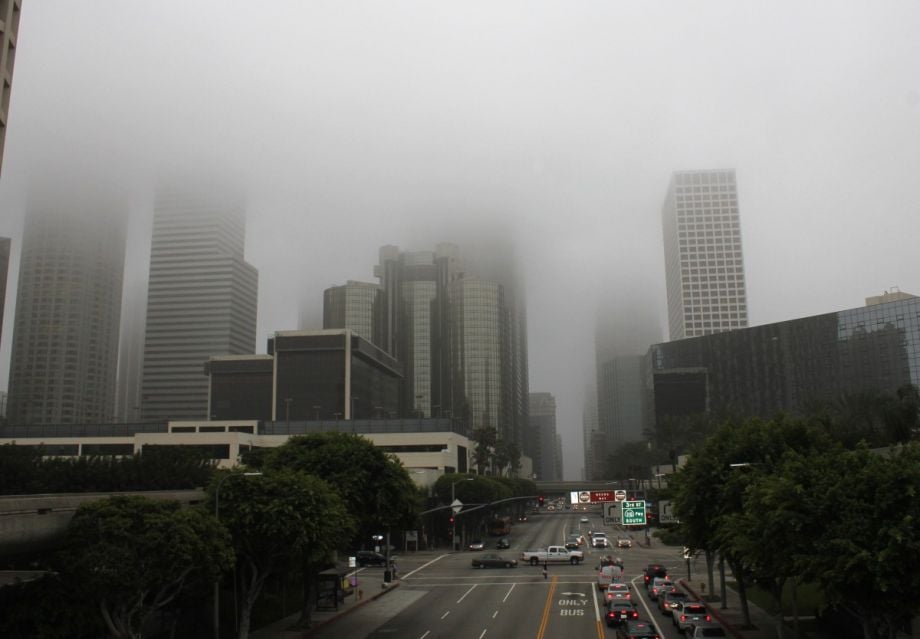Mysterious fog rolling in and shrouding whole cities is a well-worn horror trope, creeping us out in everything from Stephen King’s The Mist to the “Silent Hill” video games. What’s scarier, though, is that the opposite is happening in real life: Cities are making fog disappear.
In cities on the Southern California coast, there are fewer foggy mornings than there used to be. Around Los Angeles, for example, the frequency of fog (which is a cloud that sits at or near ground surface) has declined by almost two-thirds in the last six decades. Around San Diego, it’s dropped by 25 percent. Clouds also appear less frequently higher up in the atmosphere. The change has implications for everything from drought to energy use.
“The importance of fog to Southern California ecosystems is what made me want to know whether coastal California has undergone any change … and whether changes should be expected in the future,” climatologist Park Williams says.
Williams’ interest in clouds started one summer in college, when he was working as an undergraduate researcher in southern Costa Rica, where he watched clouds roll in off the ocean every day and “inundate the mountains.” Later, in grad school at UC Santa Barbara, he studied pine forests on the Channel Islands of the Southern California coast and saw how much fog can matter.
“Those forests probably owe their survival after the end of the last glacial period to the existence of summer coast fog,” he says.
In 2009, he began work on figuring out what makes SoCal’s summer cloud system tick. He and colleagues from the University of California, Oregon State University and NASA’s Goddard Institute for Space Studies gathered detailed meteorological data from 24 airports and airfields around L.A., San Diego, Santa Barbara and the Channel Islands. They combed through records of summer cloud frequency and height going back to 1948, looking for trends and connections to other variables like sea and air temperatures and wind patterns.
The airport records showed conflicting trends.
“Some places saw major decreases in summer cloud frequency while others saw little change,” Park says. Cloud frequency declined across the L.A. and San Diego areas, especially at the lowest heights, indicating that the clouds were being pushed upward. The Channel Islands, meanwhile, saw a slight decrease in overall cloud frequency, but a huge increase in fog. This suggested, says Park, that while large-scale climate processes were at work, something was also happening on a smaller scale, and some local process was changing cloudiness for better or worse at some sites, but not others.
When the researchers looked at the locations of the airports on census and land use maps from 1950 and from today, the trends began to make sense and the fog-killing culprit was revealed. The places where fog and cloud frequency dropped were all close to areas that had urbanized over the years. The urban heat island effect means higher temperatures at night and in the early morning, which prevents water from condensing near ground level. That reduces fog and pushes clouds to greater heights, where they become thinner and dissipate quicker.
While Southern California’s foggy coastline is an iconic postcard-ready image, there’s more than just aesthetics at stake here. Fog and low clouds provide shade and precious water to the notoriously dry region, helping to regulate temperature, stave off drought and wildfires, reduce energy demands, and give coastal trees and other plants something to drink. (Farther north, California’s famous coastal redwoods get most of their water from fog drip.) Fewer clouds and less fog could mean worse drought conditions, hotter cities (which, in turn, would mean even less fog), and more demand for water and energy to keep buildings cool. On the bright side, though, chasing the fog and clouds away could improve solar energy capture and reduce traffic accidents by improving visibility.
Southern California isn’t alone in having this problem. Urban sprawl and urban warming are global phenomena and Park’s findings are relevant to other urban coastal areas with similar climates, like those along the Mediterranean and on the west coasts of South America, South Africa and Australia.
It’s not too late to address the issue, though. Many of the steps urbanites and municipal governments are already taking to green their cities — like employing “green roofs” and planting more trees on streets — can help curb the heat island effect. Park also suggests keeping parks and open spaces from being re-developed and using permeable paving materials that let water get down to the soil where it can re-evaporate and cool and humidify the ground.
While efforts to “Save the Fog” might not have the same broad appeal as other pressing environmental concerns, ignoring fog’s loss could have very high costs. “Summer clouds are big buffers against the effects of global warming,” says Park. “But with substantially reduced summer cloud cover, urban areas of coastal Southern California are effectively allowing themselves to develop a local climate type that is less coastal and more desert like.”
The Works is made possible with the support of the Surdna Foundation.
Matt Soniak writes about science, history and Bruce Springsteen for a variety of outlets. His work has appeared in print and online for Mental Floss, The Week, Slate, Men’s Health, Scientific American, The Atlantic, ScienceNow and others. He lives in Philadelphia.




_920_518_600_350_80_s_c1.jpg)












